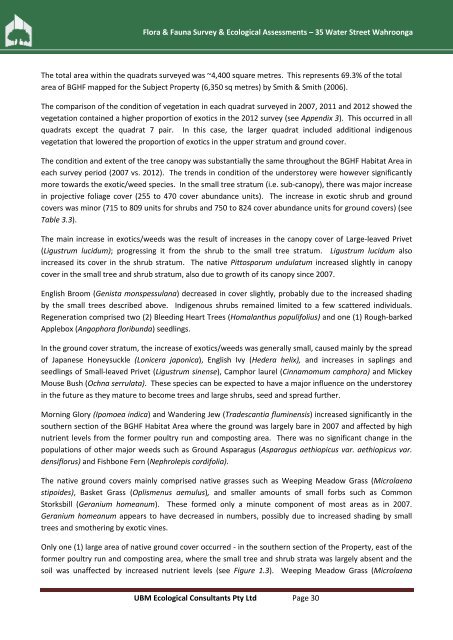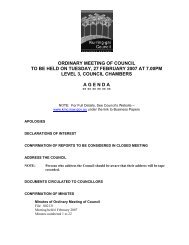Flora & Fauna Survey & Ecological Assessment (pdf. 5MB)
Flora & Fauna Survey & Ecological Assessment (pdf. 5MB)
Flora & Fauna Survey & Ecological Assessment (pdf. 5MB)
Create successful ePaper yourself
Turn your PDF publications into a flip-book with our unique Google optimized e-Paper software.
<strong>Flora</strong> & <strong>Fauna</strong> <strong>Survey</strong> & <strong>Ecological</strong> <strong>Assessment</strong>s – 35 Water Street Wahroonga<br />
The total area within the quadrats surveyed was ~4,400 square metres. This represents 69.3% of the total<br />
area of BGHF mapped for the Subject Property (6,350 sq metres) by Smith & Smith (2006).<br />
The comparison of the condition of vegetation in each quadrat surveyed in 2007, 2011 and 2012 showed the<br />
vegetation contained a higher proportion of exotics in the 2012 survey (see Appendix 3). This occurred in all<br />
quadrats except the quadrat 7 pair. In this case, the larger quadrat included additional indigenous<br />
vegetation that lowered the proportion of exotics in the upper stratum and ground cover.<br />
The condition and extent of the tree canopy was substantially the same throughout the BGHF Habitat Area in<br />
each survey period (2007 vs. 2012). The trends in condition of the understorey were however significantly<br />
more towards the exotic/weed species. In the small tree stratum (i.e. sub-canopy), there was major increase<br />
in projective foliage cover (255 to 470 cover abundance units). The increase in exotic shrub and ground<br />
covers was minor (715 to 809 units for shrubs and 750 to 824 cover abundance units for ground covers) (see<br />
Table 3.3).<br />
The main increase in exotics/weeds was the result of increases in the canopy cover of Large-leaved Privet<br />
(Ligustrum lucidum); progressing it from the shrub to the small tree stratum. Ligustrum lucidum also<br />
increased its cover in the shrub stratum. The native Pittosporum undulatum increased slightly in canopy<br />
cover in the small tree and shrub stratum, also due to growth of its canopy since 2007.<br />
English Broom (Genista monspessulana) decreased in cover slightly, probably due to the increased shading<br />
by the small trees described above. Indigenous shrubs remained limited to a few scattered individuals.<br />
Regeneration comprised two (2) Bleeding Heart Trees (Homalanthus populifolius) and one (1) Rough-barked<br />
Applebox (Angophora floribunda) seedlings.<br />
In the ground cover stratum, the increase of exotics/weeds was generally small, caused mainly by the spread<br />
of Japanese Honeysuckle (Lonicera japonica), English Ivy (Hedera helix), and increases in saplings and<br />
seedlings of Small-leaved Privet (Ligustrum sinense), Camphor laurel (Cinnamomum camphora) and Mickey<br />
Mouse Bush (Ochna serrulata). These species can be expected to have a major influence on the understorey<br />
in the future as they mature to become trees and large shrubs, seed and spread further.<br />
Morning Glory (Ipomoea indica) and Wandering Jew (Tradescantia fluminensis) increased significantly in the<br />
southern section of the BGHF Habitat Area where the ground was largely bare in 2007 and affected by high<br />
nutrient levels from the former poultry run and composting area. There was no significant change in the<br />
populations of other major weeds such as Ground Asparagus (Asparagus aethiopicus var. aethiopicus var.<br />
densiflorus) and Fishbone Fern (Nephrolepis cordifolia).<br />
The native ground covers mainly comprised native grasses such as Weeping Meadow Grass (Microlaena<br />
stipoides), Basket Grass (Oplismenus aemulus), and smaller amounts of small forbs such as Common<br />
Storksbill (Geranium homeanum). These formed only a minute component of most areas as in 2007.<br />
Geranium homeanum appears to have decreased in numbers, possibly due to increased shading by small<br />
trees and smothering by exotic vines.<br />
Only one (1) large area of native ground cover occurred - in the southern section of the Property, east of the<br />
former poultry run and composting area, where the small tree and shrub strata was largely absent and the<br />
soil was unaffected by increased nutrient levels (see Figure 1.3). Weeping Meadow Grass (Microlaena<br />
UBM <strong>Ecological</strong> Consultants Pty Ltd Page 30

















